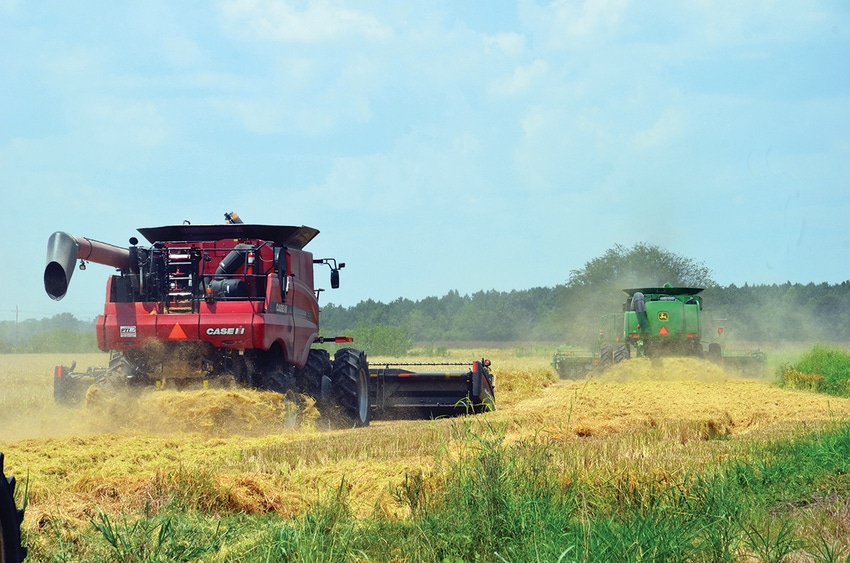July 5, 2016

Editor’s note: Download 1972-2016 U.S. Harvested Acreage Rice, Soybeans, Cotton, Corn and Sorghum Slide Show to view the charts referenced below.
USDA’s National Agricultural Statistics Service 2016 U.S. harvested acreage projections released June 30 demonstrate the productive capacity of U.S. rice, cotton, and grain producers.
Long-grain rice – second largest in current 11 years at 2.449 million acres (Chart 18).
Soybeans – largest on record at 83.037 million acres (Chart 22).
Cotton – fourth lowest in the current 10 years at 10.023 million acres (Chart 23).
Corn – third largest on record at 86.55 million acres (Chart 24).
Market considerations:
The June 30 acreage report, supply and demand as well as technical considerations, and a number of potential global anomaly and risk events (weather, political, monetary, social, military, etc.) have market participants scrambling to digest all the information and data to understand price response.
On the one hand, fundamentals and charts suggest, near-term, likely more price weakness than strength for rice, cotton and grain markets.
On the other hand, markets are screaming price uncertainty due to a lack of global economic, political and social stability, monetary intervention, weather disruptions and military positioning.
History teaches in times of high levels of global and regional uncertainty, countries tend to have greater focus on their individual country’s food, economic, energy, and homeland security — very true today. This presents a huge challenge for analysts in interpreting price impacts.
Today’s global economies have an array of potential uncertain anomaly events, as well as known potential risk events. Evaluating the last seven months of market price action, market participants are learning to anticipate unexpected price movements for rice, cotton, soybeans, wheat and feed grains.
Near-term price movement for these commodities is more likely sideways to down, but depth of price weakness and directional price changes will likely be determined by today’s event-driven markets, so caution is advised as one has to expect complex price patterns.
Price movement near-term seems more bearish than bullish, but today’s potentially inflationary stimulus-driven global economic environment and other potential known and unknown events like weather disruption, coupled with accommodative Central Banks and events like BREXIT (United Kingdom voters voted to exit from the European Union), tend to act as a price floor and can act as an unexpected catalyst for stronger prices.
USDA’s NASS personnel indicated they surveyed approximately 11,000 segments of land and 70,500 producers during the first two weeks of June to gather information on what farmers planted.
U.S. Rice – Slide Show Charts 1 to 21
Long-grain rice: U.S. long-grain rice harvested acreage increased over the previous five years for two key reasons: There appeared to be a price advantage for the 2016 long-grain rice crop over viable alternatives, and in challenging economic periods, long-grain rice across the region tends to have more yield and production certainty and profit potential than competing commodities.
2016 Arkansas long-grain rice harvested acreage is estimated at 1.425 million acres, 36 percent above 2015 harvested acres.
2016 California long-grain rice harvested acreage is estimated at 9,000 acres, 29 percent above 2015 harvested acres.
2016 Louisiana long-grain rice harvested acreage is estimated at 436,000 acres, 24 percent above 2015 harvested acres.
2016 Mississippi long-grain rice harvested acreage is estimated at 199,000 acres, 34 percent above 2015 harvested acres.
2016 Missouri long-grain rice harvested acreage is estimated at 207,000 acres, 24 percent above 2015 harvested acres.
2016 Texas long-grain rice harvested acreage is estimated at 173,000 acres, 40 percent above 2015 harvested acres.
2016 United States long-grain rice harvested acreage is estimated at 2.449 million acres, 33 percent above 2015 harvested acres.
Medium-grain rice: Total medium-grain rice acres remain basically unchanged, but the type of medium-grain had a significant change. California increased its medium-grain rice acreage by 34 percent, from 378,000 acres in 2015 to 505,000 acres in 2016. Southern medium-grain rice acreage declined by 50 percent, from 378,000 acres to 190,000 acres.
Bottom Line: A look at the previous 10 years certainly does not suggest the U.S. long-grain rice sector has the potential demand to move a U.S. long-grain rice crop this size without significant new business.
Soybeans (Chart 22)
In 2016 U.S. soybean producers are expected to harvest an estimated record 83.7 million acres, up 1 percent from last year’s 81.814 millioon and 2014’s 82.591 million. Market participants had expected an even larger harvested acreage for 2016. USDA-NASS indicated that when compared with last year, planted acreage is up or unchanged in 18 of the 31 major producing States.
NASS’s quarterly grain stocks report estimates there are 870 million bushels of soybeans stored in all positions in the United States, up 39 percent from the same time last year. NASS reports 281 million bushels of soybeans are stored on farms and 589 million bushels are off farm, with off-farm stocks up 55 percent from June 1, 2015.
Cotton (Chart 23)
2016 upland cotton planted acreage is estimated at 10.023 million acres, up 17 percent from last year’s 8.58 million acres. NASS estimated American Pima cotton at 199,000 acres or 26 percent above 2015. NASS reported:
Cotton planting was delayed in Texas due to heavy rains and severe weather. Many fields needed to be replanted due to hail damage or flooding; however, most producers were able to get the cotton crop planted within the normal planting window.
In North Carolina, South Carolina, and Virginia, cotton planted area is down from 2015.
Low yields or complete losses experienced during last year’s flooding moved farmers to plant other crops this year.
In addition, weather conditions this year in these three states have not been ideal, with reports of poor germination, extended wet soil conditions, ponding, and cool nighttime temperatures.
Corn (Chart 24)
NASS estimates 2016 corn harvested acres at 86.550 million acres, up 7 percent from last year and the third highest planted acreage since 1933. NASS reported:
Farmers responding to the survey indicated that 99 percent of the intended corn acreage had been planted at the time of the interview, slightly higher than the 10-year average.
Planted acreage for 2016 is unchanged or up compared with the previous year across most of the Corn Belt.
Ninety-two percent of this year’s corn crop was planted with biotechnology seed varieties, unchanged from last year. Biotechnology seed includes traits for insect resistance (Bt), herbicide resistance, or stacked gene, which contains traits for both herbicide and insect resistance.
NASS’s quarterly grain stocks report estimates of on-farm and off-farm stocks as of June 1 indicated there are 4.72 billion bushels of corn stored in the United States, up 6 percent from June 1, 2015, with 2.47 billion bushels stored on farms and 2.25 billion bushels stored off-farms.
Conclusion:
Long-grain rice acreage: U.S. long-grain rice acreage is very problematic without new demand and/or an event that reduces global supply or an event that heightens global food security.
Soybeans, cotton, and feed grains: Near-term (two-plus weeks) I can make a better argument for a stronger dollar than a weaker dollar. This coupled with fundamentals and technical indicators for cotton, soybeans and feed grains implies these commodities may in the near-term be in search of a price bottom.
Anomaly and risk events:
The economic state of the global economy is in a multi-year slow growth period requiring on-going fiscal and monetary stimulus. This situation is creating increasingly unexpected anomaly and risk events.
Sustained periods of anemic global growth create social unrest, political instability, unpredictable levels of fiscal and monetary stimulus, military friction, potentially unstable global governments, regional global disarray and unpredictable markets. These activities are creating increasing unexpected risk events.
Near-term market impact:
U.S. treasuries are very likely to remain sideways given its near-term bullish move (lower yields).
Near-term (next two-plus weeks) the dollar should be sideways to up, but the dollar is likely to remain range bound.
Remember, the Fed has real concerns about reaching and maintaining its 2 percent inflation objective in a stagnant global economic setting. To achieve this objective it would be helpful for oil prices to not resume their earlier declines and the dollar not to rise significantly, like they did on June 24.
U.S. equities should be watched carefully; after BREXIT they had a major sell-off followed by a rebound.
Quality investment options exist in this sector given global economic uncertainty.
Near-term, let price action provide guidance.
Rice, soybeans, cotton, corn, and wheat have had interesting price movements since December.
On the one hand, this makes one tip his hat at the Fed and global central banks for their global accommodative efforts and relative success at reflating the global economy, but there have been periods when other jesters came to mind.
I expected significant fiscal but especially monetary intervention this year, but not as early as it appeared in the first half of this year.
There is a reasonable chance that rice, cotton, soybeans, corn, and wheat may now be in search of finding a multi-year bottom, presently just a consideration.
Uncertain anomaly events and elevated levels of risk events are now with us for a number of years into the future. These events will likely exert strong influences on market participants with the potential to create major swings and directional changes in individual or multiple markets. Expect increasingly complex price patterns.
Robert Coats is a professor in the Department of Agricultural Economics and Agribusiness, Division of Agriculture, University of Arkansas System. E-mail: [email protected].
References: Rice Stocks, USDA, NASS, June 30, 2016 and Grain Stocks, USDA, NASS, June 30, 2016
About the Author(s)
You May Also Like






